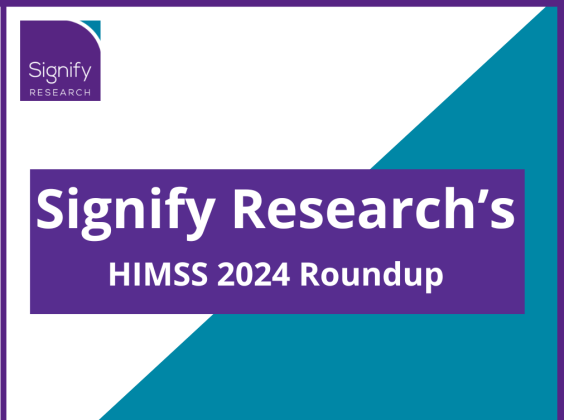
Written by

This insight provides an overview of the key developments witnessed at HIMSS from our teams that were in attendance in Orlando earlier this month. The insight is broken down into four areas of the healthcare technology industry:
The sections covering Generative AI, Digital Health and Medical Imaging are summaries of more in-depth analyses provided as part of our Signify Premium Insights subscription services. For more information on these services please click here.
Generative AI – Getting Grounded at HIMSS 2024
Last year’s HIMSS conference came just a few months after the public launch of ChatGPT, the watershed moment that brought generative AI to the forefront of mind for everyone looking to solve problems with the technology. As such, while the technology was present at last year’s event, many applications were little more than tech demonstrations, or proposed implementations, with few tools actually available to purchase and deploy at that time.
The conversation has since evolved, with a focus on responsible use catalysed by initiatives like the Trustworthy & Responsible AI Network (TRAIN). Concerns over patient safety and data security prompted discussions on establishing trust in AI solutions.
Cybersecurity emerged as a critical concern, particularly after UnitedHealth’s Change Healthcare technology unit faced a ransomware attack in February. This raised questions about data access and integration, potentially influencing market adoption.
Partnerships between vendors and providers were a highlight, addressing the need for clinical understanding and data access. Such collaborations ensure meaningful solutions and early adoption, benefitting both parties. By leveraging providers’ clinical insights and data, vendors can refine their offerings, while providers gain access to cutting-edge solutions tailored to their needs. In addition, these partnerships elevate the credibility of vendors in a sceptical market and provide prestige for providers as early adopters of innovative technologies.
While HIMSS showcased many new applications, the focus remained on what over the last 12 months has become the “established” use cases like ambient listening and medical co-pilots. Despite the sophistication of some tools, there’s a recognition of the technology’s nascent stage and the need for practical deployment strategies amidst commercial growth. The market is witnessing a gradual shift from hype to tangible applications, with vendors increasingly addressing the realities of commercialisation and deployment challenges.
Read the full Signify Premium Insight here (Subscription Required)
Digital Health – Interoperability, Virtual Health and AI
Key digital health themes at HIMSS focused on virtual hospitals, hospital-at-home programs, and data interoperability. Generative AI was of course a key them for digital health vendors with major players like Google, Salesforce, and GE Healthcare making announcements in this area.
In virtual care discussions, innovative AI-driven Smart Hospital Platforms and teleICU advancements were showcased, indicating growing confidence in the expansion of hospital-at-home programs despite regulatory uncertainties. Solutions that aim to bring healthcare services directly to patients’ homes, reducing the burden on traditional hospital infrastructure and improving access to care, especially in remote or underserved areas featured. In addition, virtual nursing and tele-nursing emerged as integral components of high-acuity telehealth solutions, demonstrating their potential to augment traditional care delivery models.
Interoperability remained a central focus, with legislative drivers shaping health information exchanges (HIEs) and networks. Regulations like the 21st Century Cures Act and CMS Interoperability and Prior Authorization Final Rule underscored the industry’s commitment to significantly improving data sharing. These regulations aim to break down data silos and facilitate the exchange of patient information across disparate healthcare systems, ultimately improving care coordination and patient outcomes. Further, the establishment of the Trusted Exchange Framework and Common Agreement (TEFCA) and the creation of Qualified Health Information Networks (QHINs) highlight efforts to standardize data exchange protocols and promote interoperability at a national level.
Read the full Signify Premium Insight here (Subscription Required)
Medical Imaging – Continuity and Constructive Conversations for Imaging IT
Cloud technology took centre stage at HIMSS 2024, with imaging IT vendors leading discussions on optimising performance through cloud services. Vendors showcased various strategies, from selecting preferred public cloud partners to adopting cloud-agnostic approaches like Kubernetes. While the conversations mainly highlighted vendor advancements, there’s a growing concern that the complexity of cloud discussions might confuse the market, prompting a need for clearer guidance to aid decision-making.
Structured reporting, particularly leveraging generative AI for auto-impressions, gained traction, indicating a shift towards broader enterprise imaging strategies. Vendors are anticipating a dynamic period ahead, with potential market disruptions from players like Solventum, Nuance (now part of Microsoft), Rad AI, and Smart Reporting.
Interoperability remained a key focus, with vendors emphasizing the integration between imaging systems and Electronic Medical Records (EMRs) to streamline patient care. Challenges persist, notably in curating relevant data to prevent information overload for radiologists.
Vendor Neutral Archives (VNAs) saw renewed interest, offering potential solutions for integration and interoperability across specialties, though enterprise imaging wasn’t a central theme.
AI vendors took a more subdued approach at HIMSS 2024 compared to specialty-specific conferences like RSNA and ECR. Many opted for attendee status, signalling a focus on relationship-building amidst funding challenges and industry consolidation.
Overall, HIMSS 2024 showcased the industry’s steady progression rather than groundbreaking trends. While technical advancements are evident, there’s a growing need for market education to help providers navigate complex technology landscapes effectively. As the industry moves forward, these considerations will remain pivotal in shaping the future of medical imaging.
Read the full Signify Premium Insight here (Subscription Required)
Clinical Care – If We Build It – They Will Come
Interoperability, device integration and data workflow in the clinical setting were key topics that were explored on vendor booths in addition to exhibit talks. The growing concerns around healthcare resource constraints and the need to simplify workflow to ease pressure on staff was a clear driver behind many of the developments exhibited at the show. The importance of data continuity and the streamlining of information integration was highlighted in the wake of the pandemic. Healthcare vendors have subsequently expediated their development of solutions that enable full disclosure of patient status.
The highlight for the clinical care team was the Interoperability showcase. The showcase itself was overflowing with vendors not only displaying their own connected solutions, but also demonstrations of how many of these devices fit within wider healthcare ecosystems. The IEEE 11073 service-oriented device connectivity (SDC) standard was the focus of a stakeholder discussion in which standard-driven bi-directional communication between devices, as opposed to the more traditional point-to-point (driver-based) communication, was a core topic. Philips, Draeger, Getinge and B Braun all discussed their involvement and provided their opinion on how the SDC will develop in the coming years to become a key standard in enabling a smart generation of healthcare.
In the short-term, regulatory (particularly FDA) approvals and cyber-security concerns will act as stumbling blocks. In the long-term, however, the implementation of SDC will enable AI-based closed-loop therapies and remote alarm management and delegation, leading to improved patient outcomes and a more efficient use of clinical resources. With approval of the SDC expected in the next 2-4 years, the likelihood of a smart ICU will soon be a reality in the not-too-distant future. For healthcare providers not yet ready to fully embrace SDC, discussion participants emphasised the standard can still be used unidirectionally in the short term but by implementing it they will be future-proofing their organisations.
Elsewhere in the exhibit hall, there was a key focus on solutions that enable workflows to integrate information at the point of care to validate the patient status and to improve efficiency. Vendors highlighted the developments that they had made to automate processes to reduce unnecessary tasks to help ease the burden on healthcare resource. Examples included using RFID’s and single-sign-on identification at the point of care to reduce unnecessary administrative tasks. AI-based analytics are also being used to identify patient status changes as early as possible to alert care givers to potential patient deterioration. Vendors such as Spacelabs, Nihon Kohden, Mindray, GE Healthcare and Philips exhibited their take on how they have taken analytics and applied it to the clinical setting to help improve patient management.
On a separate side note, it was very hard to miss the presence of the cute and cuddly dog that was competing for attention with its robotic counterpart. AT&T’s partnership with FirstNet exhibited their robotic dog, developed to provide a connected response for the Emergency Medical Services. The robotic dog utilises IoT such as beyond visual line of sight (BVLOS) operational command and control to enable remote deployment and monitoring. The FirstNet dogs, equipped with wireless cameras, are already in use with the military.
About Kelly Patrick
Kelly joined Signify Research in 2020 as a Principal Analyst. She has over 15 years’ experience covering a range of healthcare technology research at IHS Markit/Omdia. Kelly’s core focus has been on the clinical care sector, including patient monitoring, diagnostic cardiology, respiratory care, and infusion and associated IT solutions. Kelly holds a BSc degree with honours in Pharmacology from the University of Leeds. In her spare time, Kelly has a passion for running and outings with her husband and three children.
About the Clinical Care Team
The clinical care team provides market intelligence and detailed insights on the clinical care equipment and IT markets. Our areas of coverage include patient monitoring, diagnostic cardiology, infusion pumps, ventilators, anaesthesia and high-acuity IT. Our reports provide a data-centric and global outlook of each market with granular country-level insights. Our research process blends primary data collected from in-depth interviews with healthcare professionals and technology vendors, to provide a balanced and objective view of the market.
About Signify Research
Signify Research provides healthtech market intelligence powered by data that you can trust. We blend insights collected from in-depth interviews with technology vendors and healthcare professionals with sales data reported to us by leading vendors to provide a complete and balanced view of the market trends. Our coverage areas are Medical Imaging, Clinical Care, Digital Health, Diagnostic and Lifesciences and Healthcare IT.
Clients worldwide rely on direct access to our expert Analysts for their opinions on the latest market trends and developments. Our market analysis reports and subscriptions provide data-driven insights which business leaders use to guide strategic decisions. We also offer custom research services for clients who need information that can’t be obtained from our off-the-shelf research products or who require market intelligence tailored to their specific needs.
More Information
To find out more:
E: enquiries@signifyresearch.net
T: +44 (0) 1234 986111
www.signifyresearch.net




